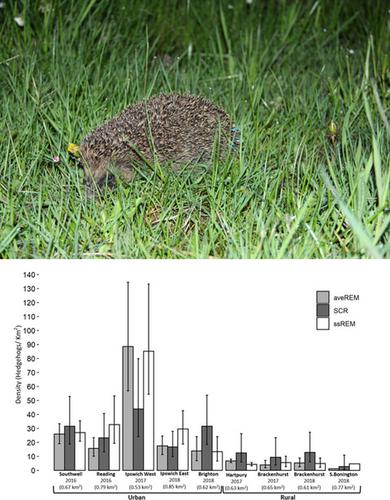当前位置:
X-MOL 学术
›
Remote Sens. Ecol. Conserv.
›
论文详情
Our official English website, www.x-mol.net, welcomes your feedback! (Note: you will need to create a separate account there.)
Application of the Random Encounter Model in citizen science projects to monitor animal densities
Remote Sensing in Ecology and Conservation ( IF 5.5 ) Pub Date : 2020-03-19 , DOI: 10.1002/rse2.153 Jessica Schaus 1 , Antonio Uzal 1 , Louise K. Gentle 1 , Philip J. Baker 2 , Lucy Bearman-Brown 3 , Simone Bullion 4 , Abigail Gazzard 2 , Hannah Lockwood 5 , Alexandra North 4 , Tom Reader 6 , Dawn M. Scott 7 , Christopher S. Sutherland 8 , Richard W. Yarnell 1
Remote Sensing in Ecology and Conservation ( IF 5.5 ) Pub Date : 2020-03-19 , DOI: 10.1002/rse2.153 Jessica Schaus 1 , Antonio Uzal 1 , Louise K. Gentle 1 , Philip J. Baker 2 , Lucy Bearman-Brown 3 , Simone Bullion 4 , Abigail Gazzard 2 , Hannah Lockwood 5 , Alexandra North 4 , Tom Reader 6 , Dawn M. Scott 7 , Christopher S. Sutherland 8 , Richard W. Yarnell 1
Affiliation

|
Abundance and density are vital metrics for assessing a species’ conservation status and for developing effective management strategies. Remote‐sensing cameras are being used increasingly as part of citizen science projects to monitor wildlife, but current methodologies to monitor densities pose challenges when animals are not individually recognizable. We investigated the use of camera traps and the Random Encounter Model (REM) for estimating the density of West European hedgehogs (Erinaceus europaeus) within a citizen science framework. We evaluated the use of a simplified version of the REM in terms of the parameters’ estimation (averaged vs. survey‐specific) and assessed its potential application as part of a large‐scale, long‐term citizen science project. We compared averaged REM estimates to those obtained via spatial capture–recapture (SCR) using data from nocturnal spotlight surveys. There was a high degree of concordance in REM‐derived density estimates from averaged parameters versus those derived from survey‐specific parameters. Averaged REM density estimates were also comparable to those produced by SCR at eight out of nine sites; hedgehog density was 7.5 times higher in urban (32.3 km−2) versus rural (4.3 km2) sites. Power analyses indicated that the averaged REM approach would be able to detect a 25% change in hedgehog density in both habitats with >90% power. Furthermore, despite the high start‐up costs associated with the REM method, it would be cost‐effective in the long term. The averaged REM approach is a promising solution to the challenge of large‐scale and long‐term species monitoring. We suggest including the REM as part of a citizen science monitoring project, where participants collect data and researchers verify and implement the required analysis.
中文翻译:

随机遭遇模型在公民科学项目中用于监测动物密度的应用
丰度和密度是评估物种保护状况和制定有效管理策略的重要指标。作为公民科学项目的一部分,越来越多地使用遥感相机来监视野生生物,但是当无法单独识别动物时,用于监视密度的当前方法将面临挑战。我们调查了相机陷阱和随机遭遇模型(REM)的使用,以估算西欧刺猬(Erinaceus europaeus)。我们根据参数的估计(平均对特定调查)评估了REM简化版本的使用,并评估了其作为大规模长期公民科学项目的一部分的潜在应用。我们使用夜间聚光灯调查的数据,将平均REM估计值与通过空间捕获-捕获(SCR)获得的平均REM估计值进行了比较。从平均参数得出的REM得出的密度估计值与从调查特定参数得出的估计值高度一致。REM密度的平均估算值也与SCR在9个站点中的8个站点产生的估算值相当;城市(32.3 km -2)的刺猬密度是农村(4.3 km 2)的7.5倍)网站。功效分析表明,平均REM方法能够在功率> 90%的两个生境中检测到25%的刺猬密度变化。此外,尽管与REM方法相关的启动成本很高,但从长远来看,它将具有成本效益。平均REM方法是应对大规模和长期物种监测挑战的有希望的解决方案。我们建议将REM纳入公民科学监测项目,在该项目中参与者收集数据,研究人员验证并实施所需的分析。
更新日期:2020-03-19
中文翻译:

随机遭遇模型在公民科学项目中用于监测动物密度的应用
丰度和密度是评估物种保护状况和制定有效管理策略的重要指标。作为公民科学项目的一部分,越来越多地使用遥感相机来监视野生生物,但是当无法单独识别动物时,用于监视密度的当前方法将面临挑战。我们调查了相机陷阱和随机遭遇模型(REM)的使用,以估算西欧刺猬(Erinaceus europaeus)。我们根据参数的估计(平均对特定调查)评估了REM简化版本的使用,并评估了其作为大规模长期公民科学项目的一部分的潜在应用。我们使用夜间聚光灯调查的数据,将平均REM估计值与通过空间捕获-捕获(SCR)获得的平均REM估计值进行了比较。从平均参数得出的REM得出的密度估计值与从调查特定参数得出的估计值高度一致。REM密度的平均估算值也与SCR在9个站点中的8个站点产生的估算值相当;城市(32.3 km -2)的刺猬密度是农村(4.3 km 2)的7.5倍)网站。功效分析表明,平均REM方法能够在功率> 90%的两个生境中检测到25%的刺猬密度变化。此外,尽管与REM方法相关的启动成本很高,但从长远来看,它将具有成本效益。平均REM方法是应对大规模和长期物种监测挑战的有希望的解决方案。我们建议将REM纳入公民科学监测项目,在该项目中参与者收集数据,研究人员验证并实施所需的分析。



























 京公网安备 11010802027423号
京公网安备 11010802027423号